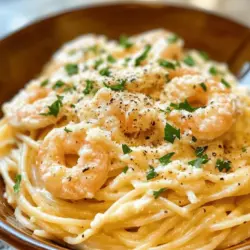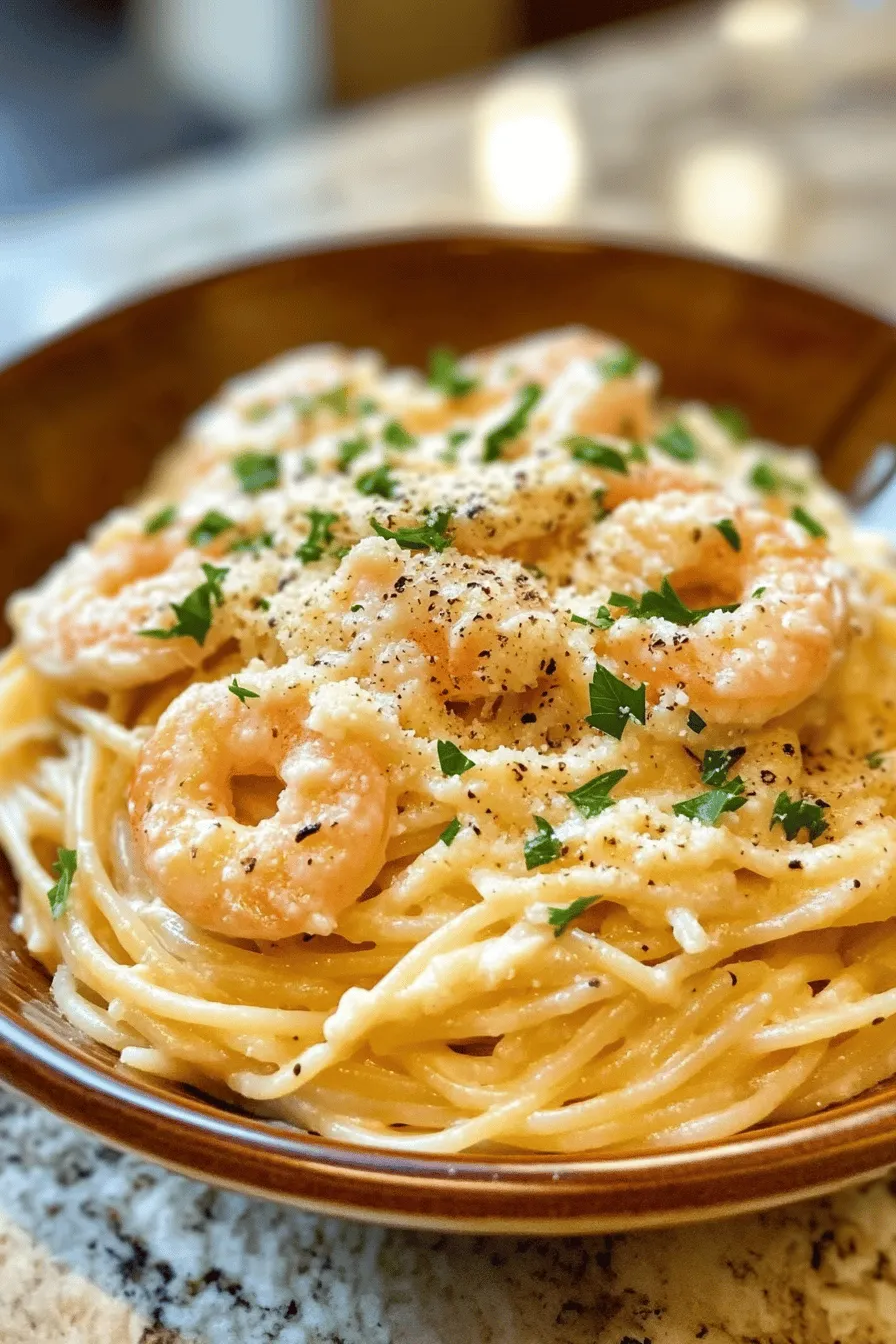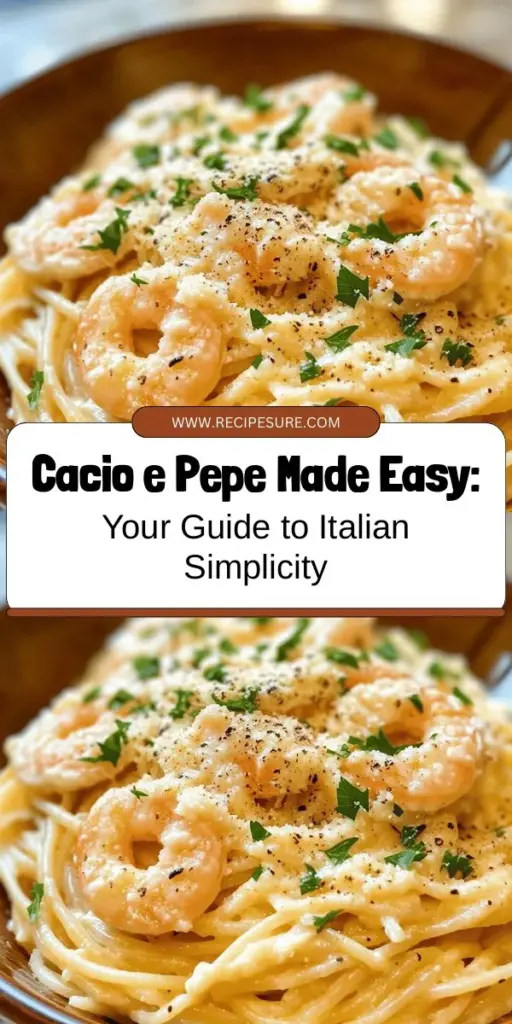In the world of Italian cuisine, few dishes resonate with the same level of simplicity and elegance as Cacio e Pepe. This classic Roman pasta dish, which translates to “cheese and pepper,” boasts a rich history and an even richer flavor profile. With just a handful of ingredients, this recipe elevates basic spaghetti into a creamy, cheesy delight that tantalizes the taste buds. Cacio e Pepe is not just a meal; it’s an experience that embodies the essence of Italian cooking. In this article, we will explore the origins of Cacio e Pepe, provide a step-by-step guide to making it at home, and highlight the key ingredients that make this dish so special.
The Origins of Cacio e Pepe
Understanding the roots of Cacio e Pepe is essential to appreciating its significance in Italian culture. This dish is steeped in history, reflecting not only the traditions of Roman cuisine but also the practicality of the shepherds who first created it.
Historical Context
Cacio e Pepe can trace its origins back to ancient Rome, where it was a staple among shepherds. These pastoral workers relied on simple, durable ingredients that were easy to transport and store. The combination of pasta, cheese, and pepper created a nourishing meal that could be prepared quickly after long hours spent in the fields. This dish exemplifies the resourcefulness of those early Romans, blending flavors that were readily available in their environment.
Over time, Cacio e Pepe evolved from its rustic roots into a beloved dish that graced the tables of Roman trattorias and eventually made its way into kitchens around the world. Its popularity grew, not just because of its simplicity, but due to the rich, comforting flavors that resonate with anyone who has had the pleasure of experiencing it.
Regional Variations
While Cacio e Pepe is intrinsically linked to Rome, different regions in Italy have developed their own interpretations of this classic dish. In Rome, it’s typically made with spaghetti or tonnarelli, but in other areas, you might find variations using different pasta shapes or additional ingredients. For example, in some regions, cooks might add garlic or even a hint of olive oil to modify the traditional recipe.
Despite these variations, the essence of the dish remains the same: a focus on quality ingredients and a simple preparation method that allows the flavors to shine. This adaptability is part of what makes Cacio e Pepe such a timeless dish, able to satisfy both the everyday diner and the refined palate.
Culinary Significance
Cacio e Pepe is considered a symbol of the Italian cooking philosophy, which emphasizes the use of high-quality ingredients and mastery of technique. In a culinary world often filled with elaborate recipes and complex flavors, Cacio e Pepe stands as a testament to the beauty of simplicity. The dish teaches us that with just a few carefully chosen elements—pasta, cheese, pepper, and butter—you can create something truly extraordinary.
The preparation of Cacio e Pepe is straightforward, but it requires a delicate touch. The art lies in balancing the ingredients correctly to achieve a creamy sauce that clings to the pasta without becoming clumpy. This attention to detail makes Cacio e Pepe a favorite among chefs and home cooks alike, as it embodies the heart of Italian cooking: honoring the ingredients through thoughtful preparation.
Essential Ingredients for Cacio e Pepe Delight
A closer look at the ingredients that make this dish not only simple but also extraordinary reveals the careful selections that transform these basic components into a culinary masterpiece.
Spaghetti: Choosing the Right Pasta
The foundation of Cacio e Pepe is its pasta, and spaghetti is the traditional choice. The long, thin shape of spaghetti allows the creamy sauce to coat each strand evenly, delivering a satisfying mouthful with every bite. However, pasta alternatives like tonnarelli, a thicker, square-shaped noodle, can also be used to enhance texture and flavor.
When selecting spaghetti, it’s essential to choose high-quality pasta. Authentic Italian brands, often made from durum wheat, yield a firmer texture that holds up well during cooking and contributes to the dish’s overall quality. Fresh or dried pasta can be used, but remember that dried pasta will require a longer cooking time. The quality of the pasta significantly affects the final dish, making this selection crucial to achieving the perfect Cacio e Pepe.
Pecorino Romano Cheese: The Star of the Show
No ingredient is more essential to Cacio e Pepe than Pecorino Romano cheese. This sheep’s milk cheese is known for its sharp, salty flavor, which perfectly balances the richness of the butter and the warmth of the black pepper. The distinctive taste of Pecorino Romano is what elevates Cacio e Pepe from a simple pasta dish to an unforgettable culinary experience.
When selecting Pecorino Romano, look for a high-quality wheel that has been aged for at least five months. This aging process enhances its flavor and texture, providing the perfect amount of saltiness and creaminess. To get the best results, grate the cheese finely just before using it; this ensures it melts easily into the pasta, creating a luscious sauce.
Black Pepper: The Perfect Spice
Freshly cracked black pepper is another key component that contributes to the signature flavor of Cacio e Pepe. The pepper adds a necessary kick that complements the richness of the cheese and butter, creating a harmonious balance of flavors.
To maximize the aroma and taste of the black pepper, it’s best to toast the peppercorns lightly before grinding them. This step releases essential oils that enhance the pepper’s natural flavor, making it even more pronounced in the final dish. When using black pepper, opt for whole peppercorns and grind them just before adding them to your pasta. This practice not only elevates the taste but also helps preserve the spice’s pungent aroma.
Butter: Adding Richness
While Pecorino Romano and black pepper are the stars of Cacio e Pepe, unsalted butter plays a vital supporting role. The butter adds creaminess to the sauce, helping to bring all the ingredients together into a cohesive dish.
Using unsalted butter allows you to control the saltiness of the final dish, ensuring that the flavors blend seamlessly. The butter should be added to the pasta at the right moment—when the pasta is still hot—so that it melts and emulsifies with the cheese, creating a silky sauce that clings to every strand of spaghetti. This step is crucial for achieving the creamy texture that characterizes a well-executed Cacio e Pepe.
—
In this first part of our exploration into Cacio e Pepe Delight, we have delved into the dish’s rich history and significance within Italian culture, as well as highlighted the essential ingredients that bring this classic recipe to life. In the next section, we will provide a step-by-step guide to making this delectable dish at home, ensuring you can enjoy the authentic flavors of Rome in your own kitchen. Stay tuned as we continue our culinary journey into the heart of one of Italy’s most beloved pasta dishes.

Alternative Fats for Flavor Variation
When preparing Cacio e Pepe, the choice of fat can significantly influence the dish’s overall flavor profile. While traditional recipes often call for unsalted butter, you can experiment with alternative fats to add unique dimensions to the dish. Here are a few options to consider:
- Olive Oil: Using high-quality extra virgin olive oil can lend a fruity and peppery note to the dish, enhancing the overall flavor while keeping it creamy.
- Pancetta or Guanciale Fat: If you enjoy a hint of meatiness, incorporating the rendered fat from pancetta or guanciale can provide a savory richness that complements the cheese and pepper beautifully.
- Margarine: For a dairy-free alternative, margarine can be a suitable substitute for butter. It will create a similar creamy texture without the use of animal products.
Whichever fat you choose, remember that moderation is key; the goal is to enhance, not overpower, the dish’s classic simple flavors.
Step-by-Step Instructions to Create Cacio e Pepe Delight
Cooking the Pasta: The Foundation of the Dish
1. Boil Water: Start by filling a large pot with water and bringing it to a rolling boil. For every pound of pasta, use at least four quarts of water to ensure even cooking and to prevent sticking.
2. Add Salt: Once the water is boiling, generously salt it. For every quart of water, a tablespoon of salt is recommended. This is your only chance to season the pasta itself.
3. Cook the Pasta: Add the pasta to the boiling water and stir occasionally. Follow the package instructions to cook it to al dente, typically about 8-10 minutes. To test for doneness, taste a strand about two minutes before the suggested cooking time.
4. Reserve Pasta Water: Before draining the pasta, remember to reserve about 1-2 cups of the starchy cooking water. This water is crucial for achieving the perfect sauce consistency.
5. Drain: Once the pasta reaches al dente, drain it in a colander but do not rinse, as the starch helps the sauce adhere better.
Toasting the Pepper: A Crucial Step
1. Choose Your Pepper: Use whole black peppercorns for the best flavor. Measure out approximately 2 teaspoons for a robust pepper profile.
2. Toast the Peppercorns: In a dry skillet over medium heat, add the whole peppercorns. Stir frequently for about 2-3 minutes until they become fragrant, careful not to burn them. You want to release the essential oils without charring.
3. Crush the Pepper: Once toasted, transfer the peppercorns to a mortar and pestle or use a spice grinder to crush them coarsely. This will release even more flavor when combined with the pasta.
Creating the Sauce: The Art of Combining Ingredients
1. Combine Pasta and Pepper: In the same skillet used for toasting the pepper, add the drained pasta.
2. Add Pasta Water: Pour in a small amount of the reserved pasta water, about half a cup, and stir to combine. This will begin to create a sauce.
3. Incorporate Cheese: Remove the skillet from heat to prevent the cheese from clumping or becoming grainy. Gradually add about 1-1.5 cups of finely grated Pecorino Romano cheese, continuously stirring and adding more pasta water as needed to create a creamy consistency.
4. Adjust Sauce Consistency: If the sauce seems too thick, add more reserved pasta water in small increments. The goal is to achieve a silky, creamy coating on the pasta without it being watery.
Final Touches: Seasoning and Serving
1. Taste and Adjust: Before serving, taste the dish to assess the seasoning. You might want to add a bit more cheese, freshly cracked black pepper, or even a pinch of salt, depending on your preference.
2. Garnishing: For a final touch, consider garnishing your Cacio e Pepe with additional grated Pecorino Romano and a sprinkle of freshly cracked black pepper. For a touch of color, a few fresh herbs like parsley can also be added.
3. Serve Immediately: Cacio e Pepe is best served hot and fresh. Plate the pasta immediately for the best experience, allowing the creamy sauce to cling beautifully to each strand.
Nutritional Information and Benefits
Cacio e Pepe is not only a delicious dish but also offers several nutritional benefits thanks to its simple ingredients. Here’s a breakdown of what you can expect in terms of nutrition:
- Caloric Content: A typical serving of Cacio e Pepe contains approximately 400-500 calories, depending on the amount of cheese and pasta used. This makes it a satisfying dish without being overly heavy.
- Nutritional Benefits:
- Protein: The Pecorino Romano cheese provides a good source of protein, essential for muscle repair and growth.
- Carbohydrates: Pasta is a great source of carbohydrates, which are vital for energy. This makes Cacio e Pepe a perfect meal for anyone needing fuel for physical activities.
- Calcium: The cheese also offers a significant amount of calcium, crucial for bone health.
- Healthy Fats: If you choose olive oil or other healthy fats, you add beneficial monounsaturated fats that can support heart health.
Conclusion
Cacio e Pepe Delight is more than just a dish; it’s a celebration of Italian culinary tradition and the beauty of simplicity. With its rich flavors and creamy texture, it serves as a perfect example of how a few quality ingredients can come together to create something truly special. Whether enjoyed as a weeknight dinner or a special occasion meal, this recipe is sure to impress and satisfy anyone who experiences it.
Embrace the art of making Cacio e Pepe at home and savor the delightful taste of this classic Italian dish. With each bite, you will appreciate the intricate balance of flavors that this beloved recipe offers. So gather your ingredients, follow the steps, and indulge in a comforting bowl of Cacio e Pepe Delight. Your culinary journey awaits!


